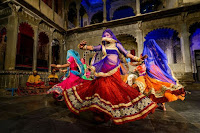A Brief Study on Folk Dance 'Ghoomar'
Ghoomar is a traditional folkdance of Rajasthan. Also known as Jhumar, this traditional rhythm was originally started by the Bhil community and performed for worshipping goddess Saraswati which was later embraced by other Rajasthani communities.The dance is chiefly performed by veiled women whowear flowing dresses called ghaghara. As a state that is home to numerous tribes and indigenous cultures, Rajasthan has several traditional folkdances to call its own. However, it is Ghoomar that reigns supreme in the royalstate.Its name comes from the word ‘ghoomna’, meaning ‘pirouetting’ or‘spinning around’.
According to the traditional rituals, newly married bride is expected to dance ghoomar on being welcomed to her new marital home. Originating in Marwar it is traditionally performed on special occasions, such as at weddings festivals and religious occasions. It features men singing and dancing together while using graceful gestures such as beating palms, snapping fingers and twirls.This dance form is performed throughout the state of Rajasthan, especially in Udaipur, Jodhpur and the Kota-Bundi regions.
Interestingly, Ghoomar is not only an act of singing and dancing but this folkdance is also a symbol of womanhood--a rite of passage in which young girls participate, declaring that they are entering woman hood.Young girls took part in this dance,making it known to everyone that they were stepping into womanhood. But today, this dance can be performed by women of all ages and is mostly cherished as a historically and culturally-rich entertainment form. It showcases the rich culture of Rajasthan through aesthetically pleasing movements and traditional attire.
Though Ghoomar is well liked globally, it has recently been popularized through actress Deepika Padukone’s dance sequence in a song in the 2018 period drama film, 'Padmaavat’.The song is named after the folk dance 'Ghoomar' and the song is sung by Shreya Ghoshal and Swaroop Khan. Padukone considered the song as "one of the most difficult song sequences" she had performed.
Style:
The dance is performed by a group of women, wearing a veil on their head and donninga traditional outfit. It can also be performed solo.The rhythm is upbeatand the women use graceful and elegant gestures, like pirouettes, fingersnapping beating palms and other hand and foot movements to maintainthe tempo.The reisonepatent step that’s done by everyone, called ghoomnawhich involves women twirling around while the ghagra creates a whirling effect. The coordinated movements among women, along with their swirling colourfulattire,make the dance intriguing to watch. Also,to accompany the dance some men and women sing along, resulting in a beautiful harmony that leavesthe spectator in awe.
Dress:
To show joy and happiness, the women are seen wearing beautiful, colorful blousesin vibrant colors like red, green, orange, pink, blue with heavy
embroidery o rmirror work.The colorful translucent veil that covers could havemirror work,or lace threaded work onit. Skirts are wide enough and
flaring with the twirling movement with anything from colorful stripes with embroidered sections, zari border sand lightly distributed motifs as design to provide extraordinary allure during the dance.The fabric generally preferred is cottonbut could include chiffon. Colors like red and green with golden colored embroideryare quite popular and supposed to indicate prosperity and high
spirits.
Songs:
As a traditional dance, Ghoomar often includes traditional songs such as "Gorband", "Podina", "Rumal" and "Mor Bole Re". Songs might be centered on royal legends or their traditions.
- "Jaipur jao to"- Traditional Rajasthani Folk Dance
- "Aave Hichki" - Traditional Rajasthani Ghoomar song"
- "Jawai Ji Pawna" - Rajasthani folk song



Comments
Post a Comment